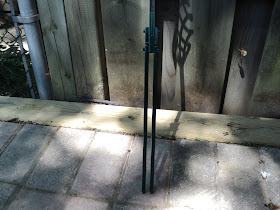
That clamp affair has to be deleted, and replaced by a foot long spike or spikes. (We had quite a wind storm yesterday; there are downed leaves all over the place.)
The clamp is tack-welded to the staff at four places, two on either side, like so.

I don't want to shorten the staff at all, so I'll cut the welds with that cut-off wheel in the Dremel.
- - -
Here's a view of some progress at weld cutting.

Reinforced cut-off wheels are awesome. They see a fair bit of use around here.
Anyway, sufficient cutting, plus a little persuasion from a hammer and chisel got me to here.

Now I have to file flat what's left of the welds on the staff, and prepare the spikes. I've found some material for spikes that should work nicely.

Those are tractor drive shafts from scrapped Okidata 320T dot-matrix printers. They're 7mm square cross-section, 12 7/16" long. I'll put pointy ends on them in the lathe, and attach them at either side of the end of the staff with screws and nuts. This hook won't be supporting anything very heavy, so this should work fine.
- - -
Here's a view of the spikes assembled to the staff.

Those are one-inch long 6-32 hex socket head screws with undersize, 1/4" A/F hex nuts. There's no need for lockwashers -- at final assembly I'll apply CA adhesive as a threadlocker, and as a sealant for the staff/spikes interface.
Drilling the 9/64" screw holes very precisely was a bit of a challenge. Here's how I went about it:
a) With masking tape applied as a layout marking aid, I laid out, spotted and centre punched the hole locations on one of the spikes. 'Drilled 3/32" pilot holes. 'Followed up with 9/64". That got me a 'template' for drilling the other spike.
b) I 'ganged' the two spikes together in the drill press vise, and drilled through the undrilled spike using the drilled spike as a template.
c) The square spikes are 7mm A/F, the square staff is 9mm A/F; that presented a bit of a complication for applying a spike to the staff for use as a template. I did that by eye, and used a set of Vise-Grips to clamp the two items together, like so.

d) That arrangement was a bit clumsy to handle on the drill press, but it was doable, and got me the desired outcome. I ran into one interesting little snag while drilling the staff, though.
I first drilled the lower hole through the staff -- that went easily, the staff is made of mild steel. When I got most of the way through drilling the remaining hole, the HSS twist drill began shrieking and ceased to make progress. I had to switch to a cobalt drill to finish drilling the hole.
(If I may digress here a bit, I've had incidents before of steel exhibiting variations in hardness; it's not an uncommon occurence. One time, I had to cut through two 'identical' bolts with an angle grinder in the course of an exhaust system repair on my Ford Ranger. The first bolt presented no great difficulty -- the grinder's wheel went through it about as I expected it to. The second bolt was significantly harder; it was all I could do to get the grinder to make progress.)
Anyway, I just have to give the two stakes pointy ends, and I can make this item paint ready.
Chucking Square Rod
My four-jaw chuck doesn't close down far enough to hold 7mm A/F square rod, so I came up with this method of chucking the rods for pointing the ends.

That's a three-inch length of 20mm diameter hardwood dowel. The square rod measures exactly 9mm across its rounded corners, so I bored the dowel through 8.5mm diameter. 'Hammered the rod through the bored dowel and there we are -- square material concentrically chucked in a three-jaw chuck. And here's a view of the outcome.

That worked nicely. I'm sure that's not the last time I'll have use for that method.
One more pointy end, and I can assemble and paint the thing. I'll add a photo of the finished item when I get it all done.
- - -
SATURDAY, JUNE 30, 2012
Ready For Installation
Here's a view of the fully assembled and painted spikes.
The original paint job on the staff is a green/black 'hammered' finish that I wasn't about to attempt to match. Most, if not all, of what I painted will be in the ground, anyway.
And here's the hook doing its job.
We'll see if we can fatten up the hummingbirds around here.
That turned out well. That big planter is deep enough that the spikes went all the way in. The tandem spike arrangement anchors the staff quite securely. So there we are, Okidata makes fine shepherd's hook parts.
- - -
Note:
[1] You'll also see these called a 'shepherd hook', which strikes me as ungrammatical. A 'shepherd hook' would be what one would use to hook a shepherd -- not the right idea at all. 'Shepherd's hook' is correct.
# # #
# # #

